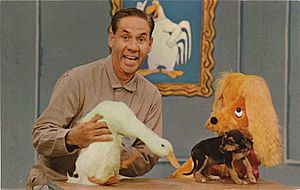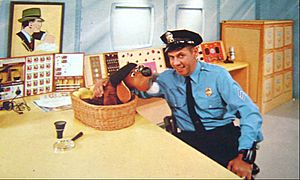Ray Rayner facts for kids
Quick facts for kids
Ray Rayner
|
|
|---|---|

Ray Rayner with Chelveston and Cuddly Dudley on Ray Rayner and His Friends in 1968
|
|
| Born |
Raymond M. Rahner
July 23, 1919 Queens, New York, United States
|
| Died | January 21, 2004 (aged 84) Fort Myers, Florida, United States
|
| Spouse(s) |
Jeanne Rahner
(m. 1949; died 1995)Marie Rahner
(m. 1997) |
| Children | 2 |
| Career | |
| Show | Rayner Shine The Ray Rayner Show The Little Show Popeye's Firehouse Dick Tracy Ray Rayner and His Friends Rocket to Adventure Bozo's Circus |
| Station(s) | WGGB WOOD (AM) WBKB-TV (later WLS-TV) WBBM-TV WGN-TV KGGM-TV |
| Country | US |
Ray Rayner (born Raymond M. Rahner; July 23, 1919 – January 21, 2004) was a famous American television host, actor, and writer. He was a big part of Chicago children's television in the 1960s and 1970s, especially on WGN-TV. Rayner was known for his friendly style and funny shows that entertained many young viewers.
Contents
Early Life and War Service
Rayner grew up in Queens, New York. His last name was originally "Rahner," but it was pronounced "Rayner." He went to College of the Holy Cross in Massachusetts. His first job in media was at WGBB radio in Freeport, New York. He worked there while studying at Fordham University.
World War II Experience
Rayner joined the Army Air Forces during World War II. He was a navigator on a B-17 plane. His plane was shot down over France in April 1943. He spent two and a half years as a POW (Prisoner of War) in Stalag Luft III.
While a POW, he helped plan the famous escape shown in the movie The Great Escape. However, he was moved to another camp before the escape happened. During this time, he found he was good at entertaining people. He would entertain his fellow prisoners and even his German captors. He was later interviewed for a documentary about Stalag Luft III.
Rayner's Chicago TV Career
After the war, Rayner worked in radio in different cities. He then joined WBKB (which became WBBM-TV) in Chicago. He started as an announcer.
Early Shows in Chicago
In 1953, Rayner hosted a morning show called Rayner Shine. This was his first time working with puppets. Later that year, he got a noon show called The Ray Rayner Show. He and his co-host, Mina Kolb, made a fun show for teens. It had music, funny skits, dancing, and pantomime. This show ran for five years.
In 1958, WBBM asked Rayner to host a children's show. He started The Little Show, which was similar to his later famous show. He also hosted Popeye's Firehouse as Chief Abernathy. In 1961, he moved to WGN-TV.
Joining WGN-TV Channel 9
At WGN, Rayner first hosted The Dick Tracy Show as Sergeant Pettibone. He also joined Bozo's Circus as a funny clown named Oliver O. Oliver. He left Bozo's Circus in 1971 to work on other projects. However, he still appeared on the show sometimes.
After Dick Tracy ended, Rayner hosted Rocket to Adventure until 1968. On this show, he dressed as an astronaut. He also appeared in McDonald's commercials as Ronald McDonald in 1968.
Ray Rayner and His Friends
In 1962, Rayner started hosting his own long-running show. It was first called Breakfast With Bugs Bunny and then renamed Ray Rayner and His Friends in 1964. The show featured old cartoons, especially Warner Brothers cartoons.
Show Segments and Characters
- Arts-and-Crafts: Rayner often did arts-and-crafts segments. He would show a finished craft made by someone else. Then, he would try to make it himself, often making a funny mess. He said his funny failures made kids feel better about their own crafts.
- Animals: The show had animals, like Chelveston the Duck. Chelveston was named after a place where Rayner was stationed during World War II. Chelveston sometimes bit Rayner, who would put duck food in his clothes to distract him. It was later revealed that four different ducks played Chelveston over the years.
- Cuddly Dudley: Rayner also had a talking dog puppet named Cuddly Dudley. Roy Brown, who played "Cooky the Cook" on The Bozo Show, created and voiced Cuddly Dudley. This segment was for viewer mail and drawings from children. Rayner and Brown would often make funny jokes together.
- Traffic and Sports: Rayner would give traffic reports from WGN Radio. During baseball season, he showed highlights of the Cubs and White Sox games. He wore a special two-billed hat that he spun around for each team.
- Other Fun: He had an annual jellybean contest where viewers guessed how many jellybeans were in a jar. Every Christmas, he used an Advent calendar. He also did lip-syncing sketches to funny songs. Another part of the show was Ark in the Park, which showed trips to the Lincoln Park Zoo with the zoo director, Dr. Lester Fisher. He also had a "How and Why" segment with J. Bruce Mitchell from Chicago's Museum of Science and Industry.
Rayner hosted Ray Rayner and His Friends until he retired from WGN in 1980.
Cartoon Segments
The cartoons on the show were mostly classic Looney Tunes and Merrie Melodies from the Golden Age of American animation. They also included other syndicated cartoons like Flash Gordon and Superman. After each cartoon, a clock with a sun drawing would appear on screen.
Actor and Author
While working in Chicago, Rayner also acted in live theater. He even directed student plays at Loyola University Chicago. In 1970, he earned a master's degree from the University of Chicago. His thesis was about how children's television should focus on entertaining kids first. He won many local Emmy awards for his TV work.
Rayner also wrote a book called The Story of Television in 1972. This book explained how a TV show is made. It included many photos of Rayner from his Ray Rayner and Friends show.
Later Years and Legacy
In 1981, Rayner moved to Albuquerque, New Mexico, to work at KGGM-TV. He said he moved because of the cold Chicago winters. He was the weatherman there and also hosted the local PM Magazine. He retired from television in 1989.
Rayner returned to Chicago for the 25th and 30th anniversary shows for Bozo's Circus. He continued to act in some Chicago theater roles. He also patiently answered questions from children about his work, even after moving to New Mexico. He taught some courses and wrote a newspaper column there.
After his first wife, Jeanne, passed away in 1995, Rayner moved to Fort Lauderdale, Florida. There, he volunteered by reading to the blind, helping terminally ill children through "Grant A Wish," and delivering "Meals on Wheels."
Ray Rayner passed away on January 21, 2004, at age 84, due to complications from pneumonia. He was survived by his second wife, Marie, his two children, and four grandchildren.
Clips from Rayner's shows are part of the WGN Christmas special, Bozo, Gar and Ray: WGN TV Classics. In 2005, the Museum of Broadcast Communications honored WGN-TV's Studio 1 for its forty years of children's television. A plaque there features Rayner and Chelveston, along with other famous WGN children's show hosts. Rayner's special coveralls, with his notes still pinned on them, are part of the museum's collection. Cuddly Dudley and his doghouse are also at the museum.
See also
 In Spanish: Ray Rayner para niños
In Spanish: Ray Rayner para niños
Images for kids




